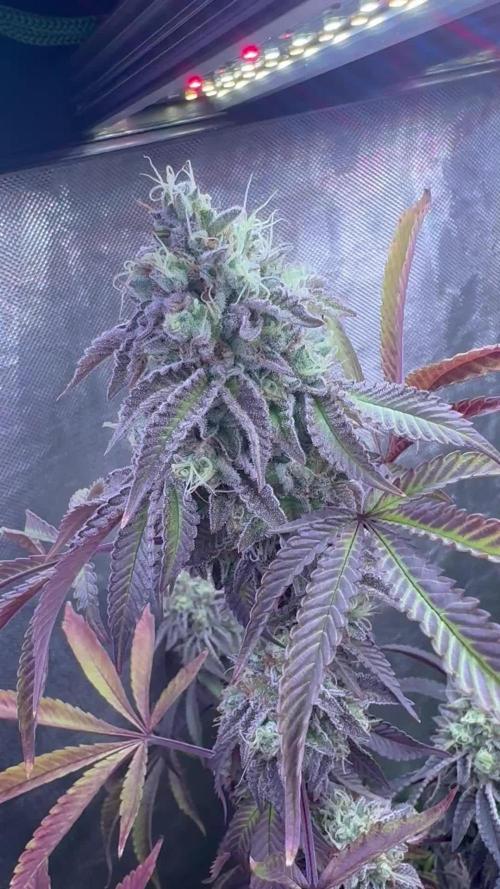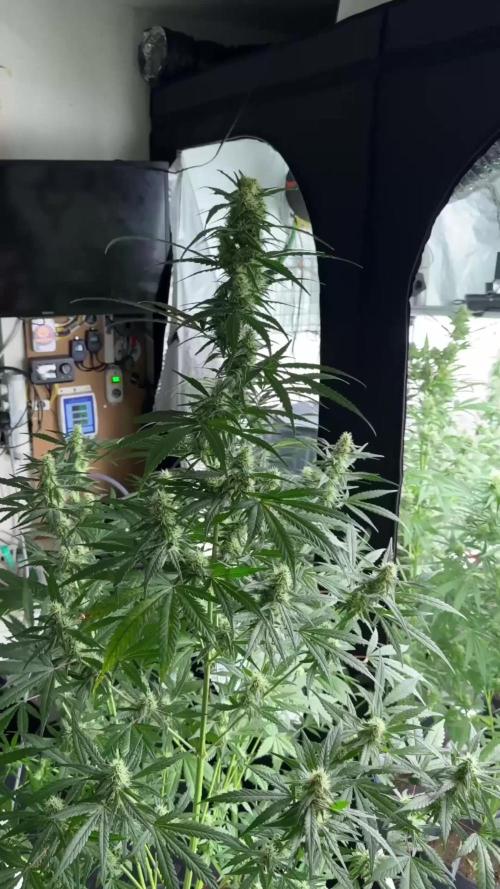The Grow Awards 2026 🏆 































Likes
Comments
Share


@MembersOnlyBud214
Follow
The boring part at flip where ur waiting to see something happen lol
Likes
59
Share


@Schneidersitz
Follow
Der Herbst ist da! Wie wunderschön sich die Blätter zum Ende der BW7 färben. Traumhaft. Sie riecht köstlich nach Mandarine, aber auch etwas nach Kuchen. Sie reift unheimlich schnell aus. Lange dauert es nicht mehr. Die Trichome sind überwiegend milchig.
Likes
15
Share


@HollowSource
Follow
She's had nothing but water for just over a week. She is starting to fade and is covered in trichomes. I've taken a little sample to try soon. Her trichomes are almost 50 50 white and clear with the odd Amber. I think she will be harvested in the next 3 to 5 days 🤞
Likes
9
Share


@FriendlyNeighbor
Follow
Taking a heavy heat wave in my area... so my girls are beeing cooked alive I hate to see them like this... I already added more CO2 to help them compensate a bit.
Well the clones are beeing flushed for almost 5 days now in 4-6 days im gonna put them into 48 h darkness and harvest wish me the best =) Trichomes are looking evenly brownish all over the plants now just like I love them :P
Also trying out the Clean fruits for flushing will see what it can do for me=)
Likes
Comments
Share


@cookingwithninja
Follow
Week 8 pics are just screenshots from vids. Been trying nugs since week 6.
Likes
5
Share


@RoyColt
Follow
Always R.O Water
Watering the plant 3 times for per week
1st Watering with nutriens.
2st Watering with nutriens.
3st Watering with only R.O water & CalMag
Likes
18
Share


@Silverback_Guerilla
Follow
2/14:
Decreased distance between the lights and canopy. Let the maximum swell commence!
2/16:
Fed today..increased sugars/carbs. This was probably the last feeding with Beastie Bloomz..switching to Cha Ching at next feed and cutting back on the One.
Likes
20
Share


@Robin87
Follow
And the first week of flower is amongst us, I’m not sure if it’s the fast bud genetics, the living soil, or a mixture of both, but I think the videos say it all, the deep green throughout, day 41 and just look😍. Everything’s been sitting nicely 24/7
Humidity 49~56%, temps 23~26c
This week they all received there last top feed, along with a slight bit of defoliation, some massive fan leaves! slightly over watered as you will notice in one of the videos, but I won’t be surprised if they’ve grew another few inches over night.
Likes
8
Share


@DogDoctorOfficial
Follow
🌸 Week 5 Flower – Gelonade Journey
What a week! The Gelonade girls are now stepping fully into their flower form, and it’s breathtaking to witness. The evolution is clear: their structure is leaning beautifully toward the sativa side, with long, elegant branches reaching outward and bud formations stretching gracefully. Even though Gelonade carries a 60% sativa / 40% indica balance, the girls are clearly showcasing their sativa influence, airy yet strong, expressive, and absolutely stunning.
✨ Sativa Stretch & Structure
The branching is art in motion, every node working like a painter’s brushstroke on a living canvas. The main colas are elongating, and even the funky pheno is showing its own charm in how the leaves and flowers express themselves. It’s one of those weeks where you just stand back and admire.
⚙️ Smart Growing with Sensors
The WCS2 substrate sensor from TrolMaster has been invaluable this week. It constantly reads moisture, EC, and temperature directly from the soil, helping to decide exactly when to feed and when to hold back. Instead of guessing, we’re guided by real data, a powerful ally for keeping the roots in balance.
💧 Nutrient Recipe Update
This week we reintroduced Aptus All-In-One Liquid at 1 ml per liter, complementing the standing mix of Aptus Regulator, CalMag Boost, and Plagron Power Buds, Sugar Royal, and Green Sensation. The reasoning is simple: as the flowers demand more, a little extra balanced nutrition ensures the canopy stays lush while the energy shifts toward bud production.
💡 Inner Canopy Lighting
One of the biggest joys this run is the extra canopy lighting. The Future of Grow and ThinkGrow LEDs shine from above, but the added under-canopy strips are filling gaps and ensuring photons penetrate deeply. Instead of shadowy corners, the girls are glowing top to bottom, every leaf touched by light.
🌿 Recap & What’s Next
From seed to now — germination, veg, stretch, and into this fifth week of flower — the Gelonades have shown resilience and individuality. Pheno #2, with her unicorn leaves, continues to amaze, while both are stacking into tall, elegant forms.
For next week, we expect more density building, pistils shifting color, and the first whispers of resin glands sparkling under the LEDs. The journey forward promises more fragrance, more structure, and more beauty still to come.
💚 Closing Thought
This week, the Gelonades remind us of the elegance of balance, between sativa and indica, between stretch and strength, between data and instinct. Every leaf, every branch, every bud is a note in a song that is only just beginning to play.
May the branches stretch without fear,
may the buds swell with light,
and may each day bring us closer
to the harvest of dreams.
📲 Don’t forget to Subscribe and follow me on Instagram and YouTube @DogDoctorOfficial for exclusive content, real-time updates, and behind-the-scenes magic. We’ve got so much more coming, including transplanting and all the amazing techniques that go along with it. You won’t want to miss it.
•GrowDiaries Journal: https://growdiaries.com/grower/dogdoctorofficial
•Instagram: https://www.instagram.com/dogdoctorofficial/
•YouTube: https://www.youtube.com/@dogdoctorofficial
⸻
Explore the Gear that Powers My Grow
If you’re curious about the tech I’m using, check out these links:
• Genetics, gear, nutrients, and more – Zamnesia: https://www.zamnesia.com/
• Environmental control & automation – TrolMaster: https://www.trolmaster.eu/
• Advanced LED lighting – Future of Grow: https://www.futureofgrow.com/
• Root and growth nutrition – Aptus Holland: https://aptus-holland.com/
• Nutrient systems & boosters – Plagron: https://plagron.com/en/
• Soil & substrate excellence – PRO-MIX BX: https://www.pthorticulture.com/en-us/products/pro-mix-bx-mycorrhizae
• Curing and storage – Grove Bags: https://grovebags.com/
⸻
We’ve got much more coming as we move through the grow cycles. Trust me, you won’t want to miss the next steps, let’s push the boundaries of indoor horticulture together!
As always, this is shared for educational purposes, aiming to spread understanding and appreciation for this plant. Let’s celebrate it responsibly and continue to learn and grow together.
With true love comes happiness. Always believe in yourself, and always do things expecting nothing and with an open heart. Be a giver, and the universe will give back in ways you could never imagine.
💚 Growers love to all 💚
Likes
6
Share


@girlsgrowguide
Follow
This week I switched up the lights. I had been using 6500k T5 bulbs that a friend gave me for free. I planned on changing two of the bulbs to 3500k when she went into flower but I could not find the right length in the 3500k. I decided to purchase a Parfactworks led. I installed the light on day 32 and transitioned her to the new spectrum. She is LOVING it! :D
Likes
15
Share


@420DeepGrow
Follow
Gracias al equipo de Seedsman y XpertNutrients sin ellos esto no sería posible.
💐🍁 Alaskan Do-Si-Dos:
Alaskan Do-Si-Dos ha sido desarrollada por expertos como una versión mejorada de la siempre popular variedad Alaskan Purple de Seedsman. La introducción de la genética Do-Si-Dos en la Alaskan Purple ha creado un híbrido índica/sativa que aumenta la potencia y el rendimiento al mismo tiempo que mejora el perfil de sabor y sigue siendo versátil en lo que respecta al cultivo en exterior.
La Alaskan Do-Si-Dos está destinada principalmente al cultivo al aire libre y en invernaderos. Las plantas crecen altas y prosperan en climas fríos, templados, cálidos y secos, al mismo tiempo que se desempeñan bien en altitud. Esto no impide que se cultive en interior, pero estas plantas grandes necesitarán mucho espacio. Las plantas muestran una resistencia moderada al moho pero, si se cultivan en interiores, hay que tener en cuenta que son RUIDOSAS, por lo que se beneficiará del uso de filtros de aire de carbón. En exterior, en latitudes septentrionales, la cosecha está prevista para finales de septiembre, mientras que en interior las plantas tardarán entre 8 y 10 semanas en completar la floración. Los rendimientos en exterior son muy altos y pueden superar fácilmente los 750gr/planta, mientras que en interior los rendimientos son elevados, hasta 600gr/m2. Los cogollos maduros tienen una densidad media y mantienen un color verde medio.
🌻🚀 Consigue aqui tus semillas:
https://www.seedsman.com/eu-es/alaskan-do-si-dos-feminised-seeds-sman-aldsd-fem
🍣🍦🌴 Xpert Nutrients es una empresa especializada en la producción y comercialización de fertilizantes líquidos y tierras, que garantizan excelentes cosechas y un crecimiento activo para sus plantas durante todas las fases de cultivo.
Consigue aqui tus Nutrientes:
https://xpertnutrients.com/es/shop/
📆 Semana 4:
Aparecieron un monton de erizos esta semana, el temporal ha hecho algo de mella en la carpa al bajar las temperaturas aunque todo sigue correcto.
Continuamos con las dosis de nutrientes recomendadas por el fabricante.
Likes
16
Share


@Chaos85
Follow
everything coming along nice density being created benefits from the added cal mag can be seen even in the old damaged leaves turning out to be a great grow
Processing
Likes
22
Share


@DankBudz
Follow
Well tying down is no longer an option, now the fight is to get them to stand up!! #shittyproblems
No let up on white hairs yet!!
It makes me sad and happy at the same time lol
Likes
36
Share


@Hempface86
Follow
All right today's day 50 and this girl is rocking and rolling... She's about half the size as I used to growing but I'm used to synthetics so for an all organic I'm happy because I can fit more plants in my tent.. with that being said she's also in less than 2 gallons of soil she's at 23 in and she is frosting up nicely... I'd like to thank the friendly people over at Zamnesia Seeds for making this possible and I highly suggest you guys checking them out for all your seeds head shop and mushroom needs.. I hope everyone is doing well and so are their girls.. happy growing everybody ✌️😎
https://www.zamnesia.com/us/
Likes
Comments
Share


@eldruida_lamota
Follow
Vamos familia, actualizamos la octava semana de floración de estas Frosty tooth de Seedstockers, aplicamos varios productos de Agrobeta, que son increíbles para aportar una buena alimentación a las plantas.
Temperatura y humedad dentro de los rangos correctos dentro de la etapa de floración.
La tierra utilizada es al mix top crop, por cambiar.
De 5 ejemplares seleccioné los 3 mejores para completar el indoor y trasplanté directamente a macetas de 7 litros, el fotoperiodo a 12/12, aplique una poda de bajos, se ven bien sanas las plantas, tienen un buen color, las plantas ya tricomaron mucho, una locura, maduraron bien ya creo que les daré matarile pronto.
Agrobeta:
https://www.agrobeta.com/agrobetatiendaonline/36-abonos-canamo
Hasta aquí todo, Buenos humos 💨💨💨.
Likes
6
Share


@ReggaeShark_420
Follow
Day 37 For the Monkey. She had started to show some pistols. The monkey arms are starting to climb. She is healthy and thirsty and live the treats i give now and then

























